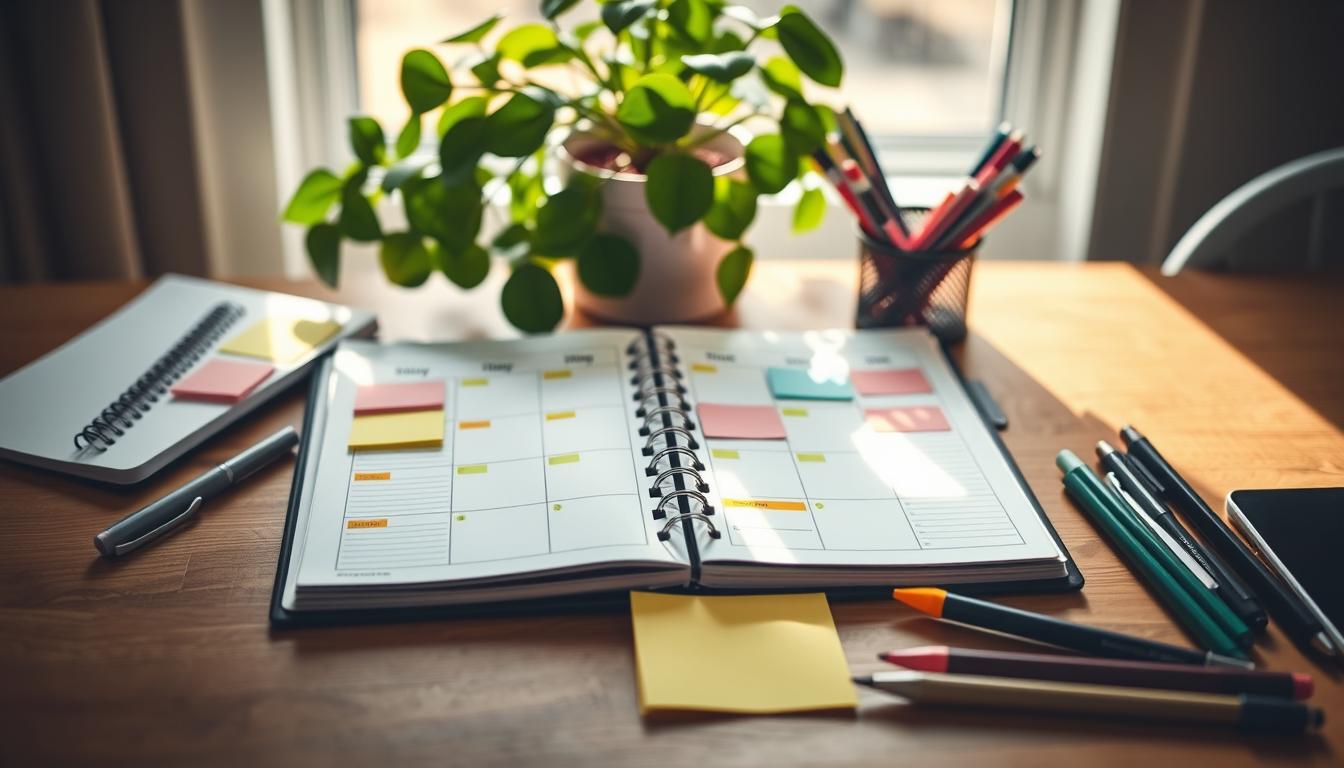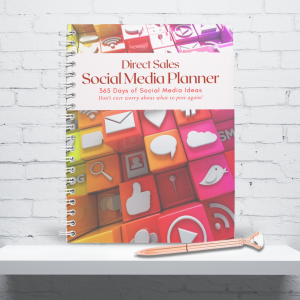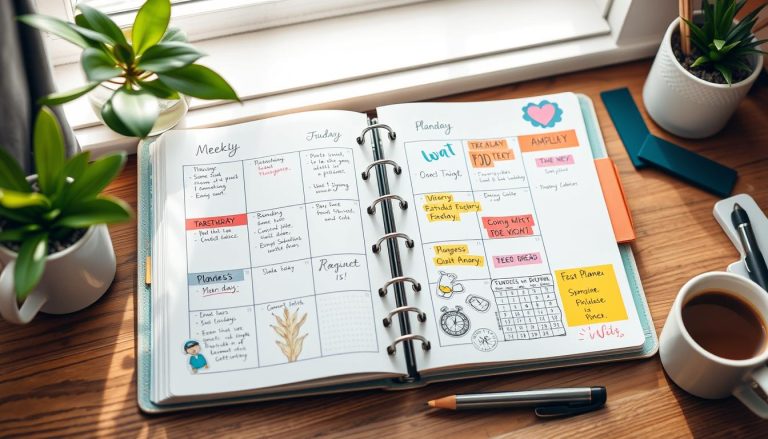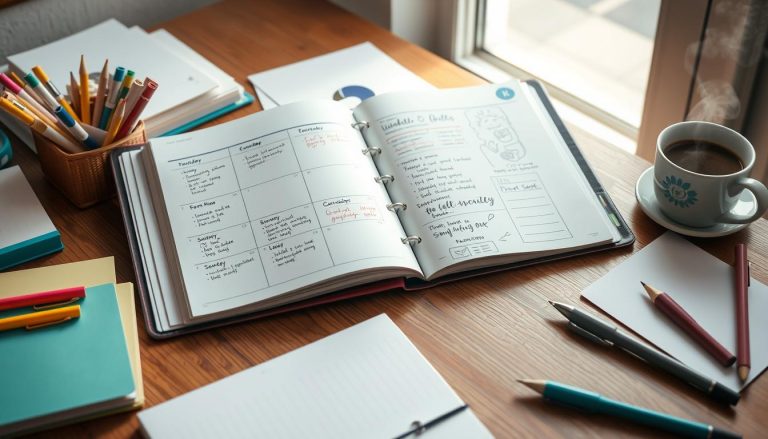Stay Organized and Stress-Free: How to Use a Weekly Planner Effectively
In today’s fast-paced world, managing our time and staying organized is key. The weekly planner is a powerful tool for this. It helps you control your schedule, lowers stress, and boosts productivity. This guide will show you how to use a weekly planner to its fullest potential.
Key Takeaways
- Discover the mental health and anxiety-reducing benefits of weekly planning
- Learn how to improve your time management and increase productivity
- Understand the essential components of an effective weekly planner
- Explore techniques for creating a practical and successful planning routine
- Discover strategies for balancing personal and professional commitments
Understanding the Benefits of Weekly Planning
Adding a weekly planning routine to your life can bring many benefits. It can improve your mental health and boost your productivity. By setting aside time for planning and goal-setting, you can reduce stress and find a better balance between work and life.
Mental Health and Reduced Anxiety
Weekly planning can help your mental health. It lets you plan your tasks and appointments ahead of time. This reduces uncertainty and stress, common causes of anxiety.
By planning ahead, you can prepare for challenges and make time for self-care. This helps you feel more in control of your day.
Improved Time Management
Good weekly planning is key to managing your time well. It lets you schedule tasks and avoid distractions. This way, you can focus on what’s important and avoid wasting time.
By planning your week, you can do more in less time. This leads to a sense of accomplishment and helps you reach your goals.
Enhanced Productivity Levels
Weekly planning boosts your productivity. It helps you focus on key tasks and avoid making unnecessary decisions. This keeps you moving forward and helps you stay on track with your goals.
By planning your week, you can work more efficiently. This makes your job more rewarding and fulfilling.
Weekly planning offers many benefits for your mental health, time management, and productivity. Adding it to your routine can change your life for the better. It can make you more organized, reduce stress, and help you achieve your goals.
| Benefit | Impact |
|---|---|
| Reduced Anxiety | Weekly planning helps alleviate the burden of uncertainty and last-minute decision-making, which are common triggers for anxiety and stress. |
| Improved Time Management | Effective weekly planning enables you to allocate specific time blocks for various tasks and responsibilities, minimizing distractions and ensuring efficient use of time. |
| Enhanced Productivity | Weekly planning helps you focus on the most important tasks, prioritize your workload, and maintain momentum, leading to increased efficiency and a sense of accomplishment. |
Choosing the Right Weekly Planner for Your Needs
Finding the right weekly planner is key to staying organized. You might like the feel of a paper planner or the ease of a digital one. There are many planner types to match your style and needs.
If you love the feel of paper, paper planners are for you. They come in many designs, from simple to colorful. You can find calendars, to-do lists, and notes all in one place.
Digital planners are also popular. They let you access your schedule on any device. They offer reminders, syncing, and even online collaboration tools.
Think about what you need in a planner. Consider your planning style, how much you want to customize, and what features will keep you organized.
“The key to a successful weekly plan is finding a planner that aligns with your unique needs and preferences.”
The best planner motivates you, reduces stress, and helps you reach your goals. Look at the different planner types and choose the one that suits your life and planning needs.
Essential Components of an Effective Weekly Planner
A well-designed weekly planner can change the game for staying organized and productive. It has key parts that work together. These help you manage your time, prioritize tasks, and reach your goals.
Daily Time Blocks
A good weekly planner has clear daily time blocks. This lets you set aside specific times for work, personal stuff, and self-care. Time blocking keeps you focused and stops you from overcommitting.
Priority Rankings
A top weekly planner has a way to task prioritize. You can mark tasks by priority. This helps you focus on the most important tasks first, boosting your productivity.
Goal-Setting Sections
It should also have sections for SMART goals. These areas help you set clear goals, make plans, and track your progress. Goal-setting in your planner keeps you motivated and on track with your dreams.
Adding these key parts to your weekly planner layout makes a powerful tool. It supports your time management, task prioritization, and goal setting. A well-designed planner helps you stay organized, reduces stress, and lets you reach your best.
Setting Up Your Weekly Planner for Success
Creating a good weekly planner is key to being more productive. By setting up your planner with care, you can organize your planner organization, map your goals, and sort tasks easily. You can also use color coding to make things clearer.
Start by figuring out why you need a weekly planner. Think about what you need to do, what’s important to you, and what challenges you face. This helps you make your planner fit your life perfectly.
- Decide what you need in your planner, like time slots, important tasks, and goals.
- Try out different ways to organize tasks, like by project, deadline, or who they’re for.
- Use colors to show work, personal, and social stuff.
- Have special areas for long-term goals, weekly thoughts, and tracking habits.
Remember, your weekly planner should change as you do. Be open to making it better over time. With a great planner, you can tackle daily tasks, reach your goals, and live a balanced life.
“A goal without a plan is just a wish.” – Antoine de Saint-Exupéry
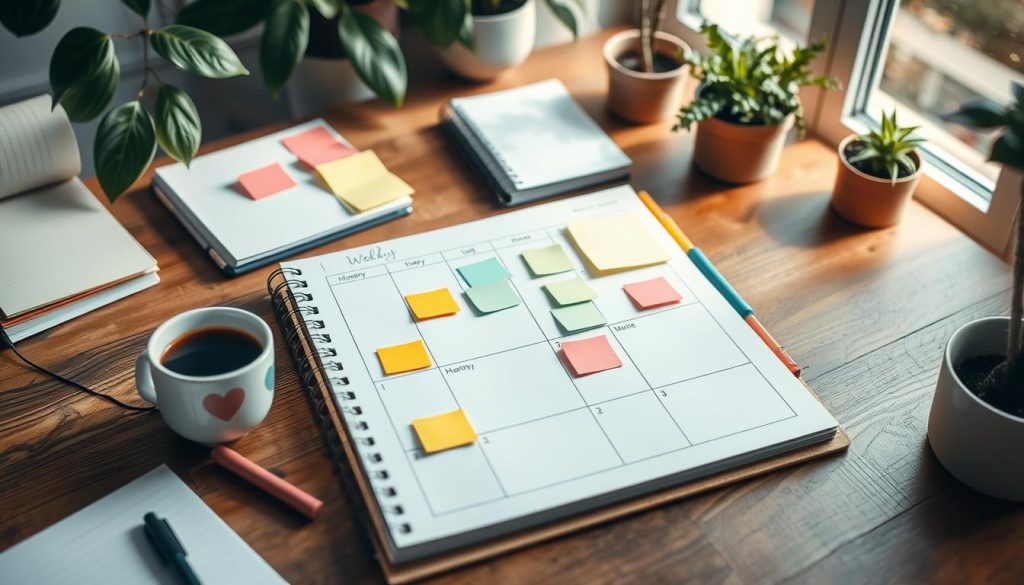
Creating a Practical Planning Routine
Creating a good planning routine is key to using your weekly planner well. It helps with daily planning, weekly reflection, goal tracking, and habit formation. By using daily, weekly, and monthly practices, your planner becomes a vital tool.
Morning Planning Sessions
Begin your day with a focused morning planning session. Spend a few minutes each morning reviewing your day, prioritizing tasks, and setting your goals. This simple habit helps you feel grounded and in control, making your day productive and stress-free.
Weekly Review Process
Make time each week for a detailed planner review. Look back at what you’ve done, see what needs work, and adjust your schedule. This weekly reflection keeps you on track with your goals and helps you live a balanced life.
Monthly Goal Alignment
At the start of each month, review your long-term goals. Make sure your weekly and monthly plans align with these goals. This goal tracking keeps you focused and motivated all year.
By using these practical planning methods, you’ll get the most out of your weekly planner. You’ll see better habit formation, less stress, and more productivity.
Time Blocking Techniques for Maximum Efficiency
The Pomodoro Technique is a top tool for boosting productivity and managing time. It helps you stay focused and get more done in your work sessions. By using this method with time blocking, you can reach your full potential and change how you do daily tasks.
The Pomodoro Technique breaks work into focused intervals, called “Pomodoros,” usually 25 minutes long, followed by short breaks. It trains your mind to stay focused, reduce distractions, and increase productivity.
Adding the Pomodoro Technique to your weekly planning can be a big change. First, pick tasks or projects needing your full attention. Then, schedule dedicated time in your planner to work on them using the Pomodoro method. This keeps you on track and makes sure you use your time and energy wisely.
There are other strategies for better time management in your weekly planning. Time blocking is one, where you set specific times for different tasks or activities. It helps you focus on what’s most important, avoid multitasking, and give the right amount of time to each task.
Discovering the best time management techniques is key to being efficient. Try out the Pomodoro Technique and time blocking to see how they affect your focus, productivity, and schedule control. With practice and customization, you’ll reach your goals and find balance in your life.
“The essence of time management is to make the best use of your time. It’s about finding a balance between work, family, and personal life. With the right techniques, you can achieve that balance and thrive in all aspects of your life.”
Balancing Personal and Professional Commitments
In today’s fast-paced world, keeping a healthy work-life balance is a big challenge. But, with the right strategies and a good weekly planner, you can mix your personal and work life well. This leads to a fulfilling and stress-free life.
Work-Life Integration Strategies
Use your weekly planner to balance work and personal life. Set aside specific times for work, making sure to meet deadlines and attend meetings. Also, plan time for family, hobbies, and self-care to keep work from taking over your personal life.
Family Time Planning
Your weekly planner is great for planning quality time with your family. Schedule family activities like movie nights, outdoor trips, or game nights. Make sure to block these times to avoid work conflicts. This way, you can strengthen family bonds and make lasting memories.
Self-Care Scheduling
Adding self-care to your weekly routine is key for your well-being. Use your planner to plan time for activities that refresh your mind and body, like exercise, meditation, or just relaxing. Treating self-care as a priority helps you manage work-life balance, lowers stress, and boosts personal development.
| Work-Life Balance Strategies | Benefits |
|---|---|
| Dedicated work time blocks | Improved productivity and focus |
| Scheduled family activities | Strengthened family relationships |
| Regular self-care routines | Enhanced mental and physical well-being |
“The key to work-life balance is to treat your personal life as importantly as your professional life. It’s not about doing everything; it’s about doing the right things.”
Digital vs. Paper Weekly Planner: Making the Right Choice
In today’s world, picking between a digital tool or a paper planner is tough. Digital tools and productivity apps have their perks, but traditional planners are still loved by many. Knowing what you prefer is crucial for staying organized and calm.
Digital planners are great because they’re easy to access and update. They sync across devices and offer features like reminders and task management. Yet, some people prefer the feel of a paper traditional planner and find it less distracting.
Paper-based traditional planners give a real feel and let you organize in your own way. Writing down your plans helps you remember and stay focused. Plus, they’re seen as more dependable, avoiding tech problems.
“The right planner, whether digital or paper, is the one that aligns with your personal productivity style and helps you stay on top of your commitments.”
Choosing between a digital tool or a traditional planner depends on your needs and life. Try both to see which one works best for you and your busy week.

Common Planning Mistakes to Avoid
A weekly planner can boost your productivity and time management. But, it’s key to dodge common pitfalls that can mess up its benefits. Overcommitting and forgetting to leave buffer time are just a couple of mistakes that can slow you down.
Overcommitting Your Schedule
One big time management pitfall is filling your schedule too much. It’s tempting to pack every minute with tasks. But, this can lead to stress and make it hard to do everything well.
Neglecting Buffer Time
Not having enough buffer time is another big mistake. It’s easy to forget to leave space for unexpected things or breaks. Without it, your productivity barriers can grow, making it tough to stay organized.
Inconsistent Usage Patterns
Using your planner every week is key to getting the most out of it. If you don’t use it regularly, you’ll feel disorganized. This can make all your planning efforts seem pointless.
| Common Planning Mistake | Impact | Solution |
|---|---|---|
| Overcommitting your schedule | Stress, burnout, incomplete tasks | Leave buffer time and prioritize commitments |
| Neglecting buffer time | Productivity barriers, rushed tasks | Allocate time for transitions and breaks |
| Inconsistent usage patterns | Disorganization, missed opportunities | Develop a consistent weekly planning routine |
By avoiding these planning errors, you can make the most of your weekly planner. This will help you manage your time better and stay productive.
Incorporating Habit Tracking in Your Weekly Planner
Habit formation is key to personal growth and achieving goals. By adding habit tracking to your weekly planner, you can build good habits. This helps you move closer to your dreams, step by step.
Tracking habits in your planner lets you see patterns and celebrate wins. It’s great for starting a regular workout, journaling, or stopping bad habits. It gives you insights to help you change your behavior. With special sections for tracking, you can see your progress and stay motivated.
Using habit tracking in your planner boosts personal growth and productivity. Seeing your progress boosts your confidence and drive. It’s a powerful tool for lasting, positive change.

